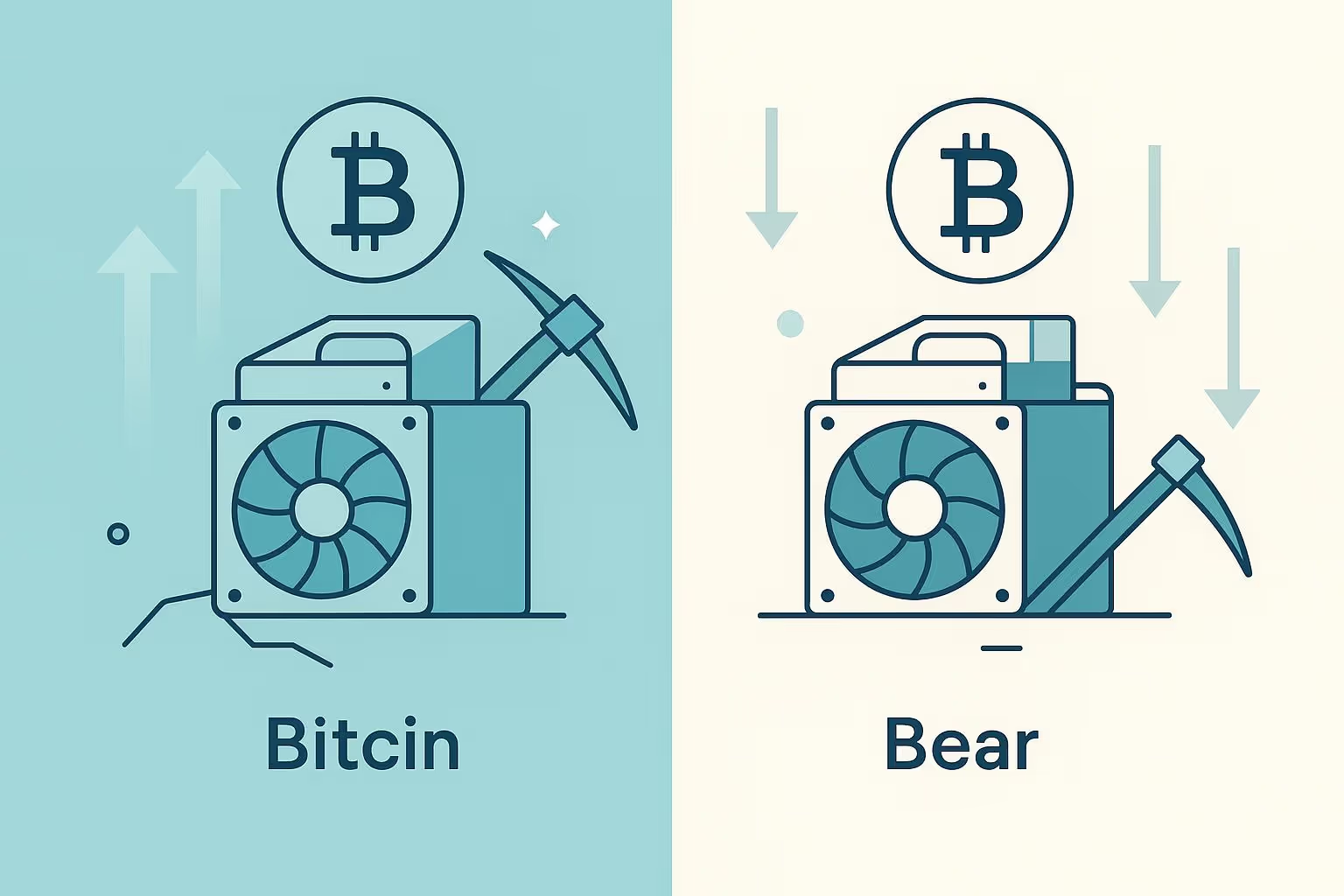Bitcoin mining operates very differently during bull and bear markets. In bull markets, rising Bitcoin prices lead to higher revenues for miners, even with increased competition and higher mining difficulty. Miners often expand operations, invest in new equipment, and hold onto their Bitcoin, hoping for further price increases. However, this strategy carries risks if the market suddenly drops.
In contrast, bear markets bring lower Bitcoin prices, shrinking profits while fixed costs like electricity remain constant. Inefficient miners often shut down, reducing competition and lowering network difficulty. Surviving miners focus on cutting costs, upgrading to more efficient equipment, and selling mined Bitcoin immediately to cover expenses. They may also take advantage of discounted equipment and reduced competition to strengthen their position.
The key to long-term success lies in preparing during bull markets - building cash reserves, upgrading infrastructure, and managing risks - so miners can weather the challenges of bear markets and emerge stronger for the next upswing.
1. Bitcoin Mining During Bull Markets
Profitability Dynamics
Bull markets are a golden period for Bitcoin miners. As Bitcoin's price climbs, miners see their revenues soar without needing to make major operational changes. But there’s a catch - higher prices lure more miners into the game. This influx increases the network's hash rate and mining difficulty, making it harder to earn Bitcoin. For example, after Bitcoin's third halving in May 2020, mining profitability surged during the following bull market. Yet, as competition intensified, the rewards per unit of work started to shrink.
Operational Strategies
In these bullish times, miners often ramp up their spending. They invest in cutting-edge hardware and expand their facilities to maximize output. Many also adopt a "mine-to-HODL" strategy, holding onto their mined Bitcoin in hopes of even higher prices down the line. While this approach can lead to substantial gains, it’s not without its challenges.
Risk Management
The temptation to expand aggressively or hold onto Bitcoin can backfire if market conditions take a sudden turn. That’s why miners need to balance ambition with caution, ensuring their strategies are prepared for any surprises the market might throw their way.
2. Bitcoin Mining During Bear Markets
Profitability Dynamics
Bear markets can be brutal for Bitcoin miners. With Bitcoin's price dropping, revenues shrink, but fixed costs like electricity remain the same. The upside? Lower prices force less efficient miners out of the game, reducing network difficulty. For those who can weather the storm, this opens the door to earning more Bitcoin rewards with less competition.
In these tough times, only the most efficient operations manage to stay in the black. Miners using outdated, energy-hungry equipment often end up running at a loss, leading many to shut down. This "survival of the fittest" dynamic creates room for prepared miners to grab a larger share of the market.
The critical factor is the cost of mining one Bitcoin compared to its market price. If Bitcoin trades below a miner's break-even point, continuing to operate can deepen losses. Smart miners carefully calculate this threshold and make tough calls about whether to keep their rigs running or temporarily shut them down.
Operational Strategies
Surviving a bear market requires a shift in strategy. Instead of focusing on growth, miners turn their attention to cutting costs and boosting efficiency. This might mean upgrading to more energy-efficient machines, negotiating better electricity rates, or trimming operational expenses wherever possible.
Many miners adopt a "mine-to-sell" strategy during these periods. Instead of holding onto Bitcoin in hopes of future price increases, they sell their mined Bitcoin immediately to cover operational costs and maintain liquidity. While this approach sacrifices potential future gains, it can be the difference between staying afloat and shutting down.
Some miners go a step further by relocating their operations to areas with cheaper electricity or favorable regulations. Flexibility becomes a key advantage, as miners who can adapt their operations to changing conditions are more likely to survive. These cost-cutting measures also push miners to adopt stricter risk management practices, preparing them for ongoing market volatility.
Risk Management
Bear markets put mining operations through a stress test, making cash flow management a top priority. Successful miners ensure they have enough cash reserves to ride out extended downturns. Diversifying revenue streams can also help, such as offering hosting services to other miners or exploring opportunities with alternative cryptocurrencies.
Another common strategy is acquiring distressed assets, like mining equipment sold at steep discounts or securing better facility leases. Some miners also use hedging tools to stabilize earnings during volatile periods. These moves aren't about chasing maximum profits - they're about survival and positioning for the next bull market. For miners, risk management becomes the cornerstone of navigating these challenging times.
Why Bitcoin Miners will WIN BIG during the 2024 BULL MARKET
sbb-itb-c71a7d0
Bull vs Bear Market Mining: Pros and Cons
Building on earlier discussions about market-specific strategies, this section dives into the pros and cons miners face in bull and bear markets. Knowing these trade-offs helps miners adapt their operations and manage risks effectively. Each market phase brings its own set of opportunities and challenges that can significantly impact mining success.
| Aspect | Bull Market Mining | Bear Market Mining |
|---|---|---|
| Profitability | High revenues with strong margins; even inefficient equipment can turn a profit | Slim margins; only the most efficient setups manage to stay profitable |
| Competition | Fierce competition as more miners enter the market; network difficulty rises | Reduced competition as inefficient operations exit; network difficulty drops |
| Operational Focus | Growth and expansion; investing in new equipment and facilities | Efficiency and cost-cutting; strategies aimed at survival |
| Risk Exposure | High investment risks; potential to overextend financially | Cash flow challenges; risk of shutdowns due to low profitability |
| Equipment Costs | High prices for mining rigs due to surging demand | Lower equipment costs; opportunities to buy from distressed sellers |
| Strategic Approach | Mine-and-hold strategies to capitalize on future gains | Mine-to-sell strategies to maintain liquidity |
This comparison highlights how shifts in profitability, competition, and operational priorities shape mining strategies. During bull markets, profitability soars - even outdated rigs can generate solid returns. However, this can lead to complacency, with miners neglecting efficiency improvements. When the market flips bearish, those same inefficiencies can spell disaster. Bear markets, on the other hand, push miners to streamline every part of their operation, fostering leaner and more sustainable businesses.
Bull markets present an ideal time to secure funding, expand capacity, and build cash reserves. Meanwhile, bear markets offer opportunities to acquire equipment at discounted prices and benefit from reduced competition. The key challenge is avoiding overextension - a pitfall that has caught many miners off guard when the market takes a downturn.
Beyond operational strategies, market sentiment plays a critical role. Bull market optimism often drives excessive risk-taking, while bear market pessimism can lead to missed opportunities. The most successful miners adopt a counter-cyclical mindset: preparing for downturns during bull runs and positioning themselves for the next upswing during bearish phases.
Managed services can provide stability throughout these cycles by offering consistent maintenance and optimization, along with transparent pricing. This approach helps miners avoid hidden costs, particularly during bear markets when every dollar counts.
Conclusion
Bull and bear markets present vastly different challenges for miners, and navigating these cycles effectively requires preparation and a clear strategy. Bull markets often encourage growth and expansion, while bear markets test a miner's ability to operate efficiently and stay afloat. The miners who succeed over the long haul are those who use profitable times to prepare for leaner periods and make smart, forward-thinking decisions during downturns.
For U.S. miners, building cash reserves during bull markets is a smart move. Instead of pouring every dollar into expansion, setting aside funds to cover fixed costs during revenue slumps can make all the difference. This financial buffer becomes critical when profits shrink but operational expenses remain constant. Another priority should be boosting energy efficiency - even when margins are high, these improvements lay the groundwork for survival when profits tighten.
Timing also plays a key role. Selling outdated rigs during bull markets and investing in newer, high-performance equipment during bear markets is a counter-cyclical approach that can pay off. This mindset, which often goes against the prevailing market sentiment, is essential for staying competitive. Flexibility is equally important; miners need to adapt their strategies, switching between "mine-and-hold" and "mine-and-sell" approaches as market conditions shift.
The most successful miners treat market cycles as predictable and plan accordingly. They use bull market profits to invest in better infrastructure, upgrade equipment, and build financial reserves. When bear markets hit, these preparations allow them not only to survive but also to gain market share as less-prepared competitors are forced out.
FAQs
How can Bitcoin miners prepare during a bull market to stay resilient in a bear market?
During a bull market, Bitcoin miners have a unique opportunity to prepare for tougher times. One smart move is building cash reserves - a financial buffer that can cover operational expenses when profits take a hit during a bear market.
Another key strategy is upgrading to energy-efficient equipment and streamlining operations to cut costs. Beyond mining, exploring additional revenue streams - like offering hosting services or other mining-related ventures - can help create a more stable income. Thinking ahead and taking these steps can help miners stay resilient no matter how the market shifts.
How can Bitcoin miners cut costs and stay profitable during a bear market?
During a bear market, miners can take practical steps to cut costs and maintain profitability:
- Improve energy efficiency: Upgrading to energy-efficient hardware and tweaking mining software can help lower electricity bills. Moving operations to regions with lower energy costs is also worth considering.
- Reduce operational expenses: Take a close look at all costs, including electricity, maintenance, and internet services, to spot areas where you can save.
- Keep hardware in top shape: Regular maintenance of mining rigs can help avoid unexpected repairs and downtime. Planning for upgrades ensures your equipment stays competitive in the long run.
By prioritizing efficiency and keeping expenses in check, miners can weather tough market conditions and sustain their profits.
How do changes in Bitcoin's market price affect miners' decisions about upgrading equipment or expanding operations?
Bitcoin's price swings have a huge impact on miners and their strategies. When the market is in a bull phase, climbing Bitcoin prices make mining rewards far more lucrative. This often encourages miners to invest in better equipment or even expand their operations. But there's a catch: as more miners join the network, the overall hashrate increases, which in turn raises the mining difficulty. For miners with less efficient setups, this can quickly eat into profits.
On the flip side, a bear market tells a different story. Lower Bitcoin prices shrink mining profits, forcing some miners to shut down their rigs. When this happens, the network's overall hashrate drops, triggering Bitcoin's protocol to adjust by lowering the difficulty. This adjustment can give the remaining miners a better shot at staying profitable. Miners are constantly evaluating these market dynamics to decide whether upgrading their equipment or scaling their operations fits into their long-term plans.

